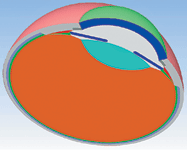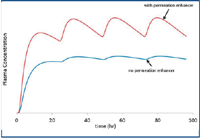Using Simulation to Improve Drug-Delivery Effectiveness
Pharmaceutical companies are responding to the high cost of introducing new drugs to market in different ways.
Pharmaceutical companies are responding to the high cost of introducing new drugs to market in different ways. For new drugs, companies are examining drug products and their delivery systems far earlier in the design phase than they have in the past to ensure success of the new drug and device combination. At the same time, existing APIs are being repurposed for new therapeutic treatments or delivered using improved formulation and delivery methods that may better resolve the physiological, biochemical, and physicochemical barriers. These shifts have increased the industry's focus on the drug-delivery platform as an enabling technology that can optimize drug efficacy and cost-effectiveness.
Simulation software is one technology that can improve device performance by allowing pharmaceutical companies to virtually model and prototype the delivery of new drugs. Various properties can be examined, including the drug's composition, particle size, flow, andhuman physiology.
Numerical simulation tools, such as finite element analysis (FEA) and computational fluid dynamics (CFD) provide a way to rapidly and economically examine a wide array of drug-delivery technologies. Early in the design cycle, numerical simulation identifies designs and operational conditions that might not meet therapeutic requirements, thereby allowing companies to address these and to develop accurate, safe, and effective design before the first prototype is developed. Later on, models can be constructed to simulate the actual drug-delivery process to humans. Although these advanced studies entail more upfront effort, especially if validation is required, they provide significant advantages over experimentally driven develoment processes. Therefore, they can decrease the chance of design changes after the product enters animal or clinical trials. This article describes these simulation technologies and related case studies.
Computation fluid dynamics tools
Because of the fluidic nature of drug delivery, CFD tools are commonly used to understand and optimize the delivery process. CFD takes advantage of numerical methods to solve the fundamental equations for fluid flow and heat/mass transfer. The process begins by creating the medical device in a computer aided design (CAD) tool or in other solid modeling software. The next step is to decompose the domain into a computation grid or mesh. Anatomic structures are incorporated as needed using one of two approaches:
- Creating an idealized anatomic model (using solid modeling software); or
- Extracting the anatomic structure from medical-scan images using segmentation software, such as Mimics (Materialise) or ScanIP (Simpleware).
Segmentation tools combine the anatomic data with the device, create a mesh, and export the meshed assembly in a format readable by most leading commercial simulation software. The user enters material property data, initial and boundary conditions, and submits the job to the CFD solver. Once the problem is converged, the user visually and quantitatively reports results for fluid flow, density, drug concentration, and other variables. Cut planes and surface plots are the most common way of displaying the results. Alternatively, one can extract point, surface, or volumetric results for quantitative comparisons to experimental or other data.
Case studies
The following case studies illustrate CFD technology applied to three classes of drug-delivery devices: inhalers, intravitreal implants, and transdermal patches.
Respiratory drug delivery. Inhalation technology is extensively used to treat obstructive airway diseases, such as asthma and chronic obstructive pulmonary disease. The development cost for a new inhalation drug is high (1). One reason for the high cost is the extremely difficult and expensive methods used to evaluate drug and device effectiveness in terms of deliverability and deposition. The cost is especially high for dry powder inhalers (DPIs) because powder management is complicated by the special physics of the powder and agglomeration effects (2). After experiments, computer simulations can assist in examining powder behavior by providing the ability to look at individual forces acting between the particles. This visual can aid in the understanding of effects, such as agglomeration, de-agglomeration, and particle deposition in the patient.
One specific tool involves particle analysis (ANSYS fluent, ANSYS), which includes a module to treat particles. The module considers the interaction between the air flow and the aerosol particles as well as particle-to-particle and particle-to-wall interactions. To understand and describe the transition from a powder pile at rest to a fully dispersed inhalable aerosol, a researcher must consider various aspects of particle physics (3, 4). The ANSYS model includes soft-sphere collisions (spring–damper–model), Coulomb forces, van der Waals forces, and surface-friction forces (static, dynamic, and rolling friction) for each particle. Slipstream effects can be considered for small particles in the vicinity of larger carrier particles. Particle rotation is tracked and transferred between particles during collisions as a function of friction forces. Particle agglomerates can be detected by their number and size to analyze the effectiveness of the dispersion. Figures 1a–1c show a powder pile inside a capsule that is dispersed by an incoming air flow. The particle module is under continual development.

Figures 1a and 1b
Ocular drug delivery. Macular degeneration, retinitis pigmentosa, and diabetic retinopathy are examples of age-related eye diseases that can benefit from sustained release approaches to drug delivery. The primary routes for delivering drug to the eye are systemic, topical, periocular (e.g., conjuctival), and intraocular (e.g., intravitreal injections or implants) (5). Topical drops, gels, and other vehicles suffer from the limitations of poor solute flux through the corneal surface and losses to fluid drainage and tear-fluid turnover. As a result, high drug concentrations are used to compensate for the losses. Conjunctival and intravitreal routes do not have the same drawbacks, so these vehicles use sustained-release systems to maintain drug concentrations at the back of the eye for extended periods of time, typically months. Simulation can provide an understanding of transient and spatial distribution of the drug throughout the eye, thus giving detailed information about what factors affect drug distribution on the target surface.

Figure 2: Eye model created sing ANSYS simulation software.
Drug transport in the eye is driven by the convection of aqueous humor, elimination, and diffusion. Convection dominates transport in the anterior chamber, whereas diffusion typically dominates in the posterior portions of the eye. A complete eye model includes both chambers because drug may be lost to sinks in either chamber. The modeling effort, therefore, begins with establishing a three-dimensional model of aqueous humor flow and elimination. First is the construction of an idealized version of a human eye (see Figure 2). Material properties for the fluids are taken from literature sources as are boundary conditions for the inflow of aqueous humor, scleral, and corneal boundary pressures, and intraocular pressure (IOP) (6, 7). Figure 3 shows results for the baseline flow pattern and intraocular pressure (IOP) on the symmetry plane of the eye. With the convection patterns established, a bolus of drug is added to the model to examine drug delivery. A bolus located in the center of the eye near the retinal surface is ideal for mass transport, but may obstruct the patient's field of view. A key question addressed by simulation, therefore, is how a peripheral bolus location impacts drug concentrations on the retinal surface. Figure 3c shows the asymmetrical delivery pattern, central depletion, and drug penetration into the retinal, choroidal and scleral tissues characteristic of peripherally placed drug boluses and implants.

Figure 3: Results of a drug-delivery model, showing (from left to right): intraocular pressure, speed countours, and distribution platforms.
Transdermal drug delivery. Transdermal drug-delivery systems (or patches) are a preferred platform for systemic drug delivery because of improved patient compliance and uniformity of plasma drug concentration over longer periods of time, relative to oral-dosage forms. The patch itself is constructed of a backing, drug depot, adhesive film, and liner. The drug depot may be a reservoir, polymer or adhesive matrix (8). A permeation enhancer is typically included in the formulation to increase the drug-diffusion coefficient in the skin or the partition coefficient at the patch–skin interface (9). The challenge of patch design is to deliver therapeutically relevant amounts of drug across a patient's skin and into the bloodstream.

Figure 4: Model geometry used in transdermal-patch simulations.
The patch model shown in Figure 4 is representative of a reservoir system. The components essential to modeling drug transport are the drug reservoir and skin layer. The capillary bed is located at the far edge of the skin region. An infinite sink boundary condition is most commonly used to model the driving force of drug through the patch and skin. This condition assumes that the concentration of free drug in plasma is so low that the actual concentration can be ignored. It is more accurate, however, to include a boundary condition that accounts for the pharmacokinetics of each drug. As part of a broader human body modeling initiative, ANSYS has implemented a three-compartment pharmacokinetic model representing absorption, distribution, metabolism, and elimination of drug using standard rate-dependent models (10). The three compartments are the plasma, target, and other tissues. Figure 5 shows the rise and fall of drug concentration in plasma after a series of 24-hour patch applications.

Figure 5: Evolution of free drug concentration in plasma over days.
Conclusion
The above examples illustrate key ways to model today's drug-delivery devices. Simulation software enables users to construct (or import) anatomical structures, model physiologic transport processes, and incorporate physical and physiological phenomena. The results can reduce testing time and cost in drug development.
Marc Horner, PhD, is lead technical services engineer in healthcare, and Dr. –IngRalf Kroeger is a senior CFD engineer, both at ANSYS.
References
1. C.P. Adams and V.V. Brantner, Health Aff. 25 (2) 420–428 (2006).
2. H. Schubert, Chem. Ing. Tech. 51 (4) 266–277 (1979).
3. J. Visser, Powder Tech., 58 (1) P1–1- (1989).
4. H. Krupp, Adv. Colloid Int. Sci. 1 (2) 111–239 (1967).
5. D.H. Geroski and H.F. Edelhauser, IOVS 41 (5) 961–964 (2000).
6. P.J. Missel, M. Horner, and R. Muralikrishnan, Pharm Res., 27 (8) 1530–1546 (2010).
7. R. K. Balachandran and V.H. Barocas, Pharm Res. 25 (11) 2685–2696 (2008).
8. S. Kandavilli, V. Nair, and R. Panchagnula, Pharm. Technol. 26 (4) 62–80 (2002).
9. J.E. Rim, P.M. Pinsky, and W.W. van Osdol, Annals Biomed. Eng. 33 (10) 1422–1438 (2005).
10. M. Horner, Desktop Eng., April 1, 2011, www.deskeng.com/articles/aabamz.htm.

Drug Solutions Podcast: A Closer Look at mRNA in Oncology and Vaccines
April 30th 2024In this episode fo the Drug Solutions Podcast, etherna’s vice-president of Technology and Innovation, Stefaan De Koker, discusses the merits and challenges of using mRNA as the foundation for therapeutics in oncology as well as for vaccines.